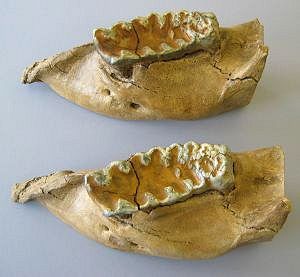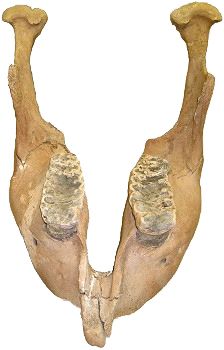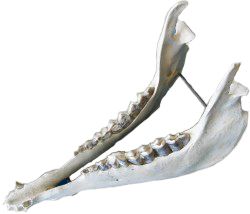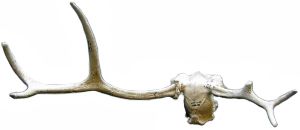
Nebraska County Fossils
Hitchcock
< Vertebrate Paleontology Home
A virtual journey through the Museum's vertebrate paleontology collection.
Stegomastodon, Short-jawed tusker
Family: Gomphotheriidae
Geologic age: Pleistocene, 1 to 1.5 million years old


Twins? Seeing double? No, these are casts (exact reproductions) of the jaw of the Hitchcock County Stegomastodon. These unique elephants became extinct about 1 million years ago. This may have been the last of his kind to roam the Nebraska countryside. This specimen, consisting of a nearly complete skeleton, was donated by Jerry and Jan Williams.
Protolabis?, Nebraska llama
Family: Camelidae
Geologic age: Miocene, about 12 million years old
Year fossil collected: 1982


"Proto" means "first", but this isn't really the first camel to live in Nebraska. Primitive camels nearly 40 million years old have been found in western Nebraska. Protolabis was one of the smallest of several species of camel that lived in Hitchcock County 12 million years ago. It was actually an early llama...and yes, modern llamas are in the camel family! The jaws and teeth of other camels from Hitchcock county fill several drawers in the Research Collections of the State Museum.
Ramoceros hitchcockensis, Hitchcock's branch-horn
Family: Antilocapridae
Geologic age: Late Miocene (Barstovian), about 14 million years old
Year fossil collected: 1982


Ramoceros hitchcockensis is an unusual antelope-like animal with asymetrical horns--that is, the "rack" on one side is very different from that on the other side. Specimens of this animal were first collected for E. D. Cope in the late 1800s in Hitchcock County, Nebraska. Jaws and teeth of Ramoceros hitchcockensisare relatively common, but complete skulls with horns, like this one collected by the State Museum in 1982, are almost unknown!
Geological Ages of Rock Formations

| Q | Pleistocene ("Ice Age") Sands, gravels, silts overlay much of the county (not shown) Pleistocene sands, gravels and silts overlay much of Nebraska and often conceal the bedrock beneath. These "Ice Age" deposits often produce the remains of mammoths, bison, horses, musk oxen, elk and other familiar mammals. Small fossils, especially, are important indicators of the climate at the time of deposition. |
| Tpo | Tertiary, Miocene/Pliocene, Ogallala Group, 2-14 million years old Ogallala Group rocks include predominantly clastic sands and sandstones composed of a mixture of Rocky Mountain debris and locally derived and re-worked sediments. Ash beds are not unusual in the Ogallala and help to precisely date the sediments. In western and southwestern Nebraska, the Ogallala beds are responsible for resistant bluffs that cap the valley sides of modern streams. |
| Kp | Cretaceous, Pierre Formation, 66-78 million years old The Upper Cretaceous Pierre Formation was deposited in the deeper portions of the Cretaceous mid-continental seaway. It consists primarily of fine black shales. Roads and structures built on Pierre Shale hillsides often slump as the shale becomes wet. The unit produces a variety of marine vertebrate fossils including fish, mosasaurs and plesiosaurs. |





